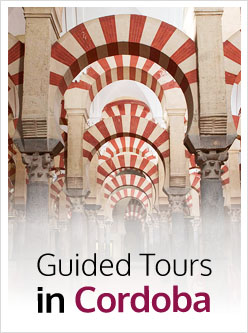Sanctuary of Fuensanta
In the east of the city of Córdoba, over the old orchards, the popular and traditional neighbourhood of Fuensanta was born, which is named after the Virgin of the city and, obviously, the Sanctuary erected in her honour.
Opposite the current church, there is a wayside cross structure erected at the end of the 15th century in order to protect the miraculous well, where, according to the legend, the small image of the Virgin of Fuensanta was found, abbreviation of “Fuente Santa” (Holy Fountain). A tiled mural, placed in 1949, tells the story with graphics and documents, of how the Virgin appeared accompanied by San Acisclo and Santa Victoria, before the humble wool comber Gonzalo García in 1420: “In this venerable place, near this Holy Fountain where nature had created a leafy wild fig, whose trunk had the holy image which is worshipped in this temple, hidden by a Christian at the entrance of the Moors in Córdoba; going out through this way a devoted man of the Queen of Heavens, called Gonzalo García, tired and saddened for having a paralytic wife, and an insane daughter. This Queen Lady appeared before him accompanied… and told him to take water from this fountain for his wife and daughter and they would be healed. He obbeyed and they were suddenly cured from their illnesses. Year 1420“.
The wayside cross structure of the Sanctuary of Fuensanta has a square floor, with three sides opened through pointed arches, whereas the fourth one is closed and contains a niche with the former inscription. It is covered by a starred ribbed vault, and its ribs are supported by corbels decorated with symbols of the Evangelists, who are represented on the keystones. The parapet of the well was made by Mateo Inurria at the beginning of the last century.
The church of the Sanctuary of Fuensanta is the result of several remodellings, one of them carried out in 1646, which altered the original structure and substituted it by a Baroque one, although there was a last intervention in 1976, in order to adapt it to its new function as the parish of the neighbourhood. The façade is made in brick and with a structure based on a stepped composition crowned by a bell gable with three openings for the bells. The entrance, made in stone, has three levels: the lower one with a parted triangular pediment, the second one has a small balcony and circular pediment with parted cornice and a circular oculus at the top level. They belong to the restoration carried out in 1647, as well as the extension of the church and the addition of the bay at the foot of the nave, according to Baroque characteristics.
The church has also a Gothic side door made in stone, with a pointed arch framed by alfiz. At the end of the 17th century a portico was attached to the side façade connecting the courtyard, with six bricked arches over stone columns, dedicated to protecting the votive offerings and there still remain the alligator, the teeth of big American fish and the whale rib.
The temple has a rectangular floor with three naves, with three sections of pointed arches supported by cross-shaped pillars, with a clear Gothic-Mudejar style. The main chapel, from the beginning of the 16th century, can be accessed through a pointed supporting arch and it is covered by a Gothic ribbed vault. On the side walls there are stone plaques remembering the miraculous appearance of the image of the Virgin.
At its front there is a niche from the 17th century with the image of the Virgin of Fuensanta that can be accessed from the outside through a red marble stairway, covered by a vault decorated with plasterwork.
From the chapels we could highlight the one located on the side of the Gospel, with an image of Santa Ana con la Virgen Niña (Saint Anne with the Virgin Kid)at the front, and on both sides the busts of an Ecce Homo and a Dolorosa (Virgin) in two small urns. On the table of the altar there is a reliquary of the Holy Cross made in wood and with the shape of a pyx. On the other hand, the chapel of the apse on the side of the Epistle, called Chapel of the Tabernacle or of the Christ of Mercedes, has several fresco paintings representing angels with the symbols of the Passion on the vault, attributed to Antonio del Castillo y Saavedra from Córdoba.
At the foot of the church, we can see the Chapels of San José and of the Christ of the Wayside Cross, built at the beginning of the 20th century and flanking the choir located over the hall entering the temple.
If you are not sure what to do in Córdoba, we recommend you visit the Sanctuary of Fuensanta hiring one of our guided tours. Choose to do high quality sightseeing with qualified staff. Do not hesitate, ArtenCórdoba is the best option.
Text: J.A.S.C.


Elige el tour que más se ajuste a tus necesidades y reserva tu plaza en una de nuestras visitas guiadas regulares.
Las Visitas guiadas regulares son aquellas a las que puedes apuntarte de forma individual, se realizan regularmente y en un solo idioma, castellano o inglés
Visita Guiada Mezquita-Catedral de Córdoba
5 / 5
13€
Visita Guiada Mezquita de Córdoba y Judería
5 / 5
Desde
17€
Visita Guiada Córdoba a Fondo
5 / 5
Desde
40€
Visita Guiada Medina Azahara
5 / 5
Desde
18€



















